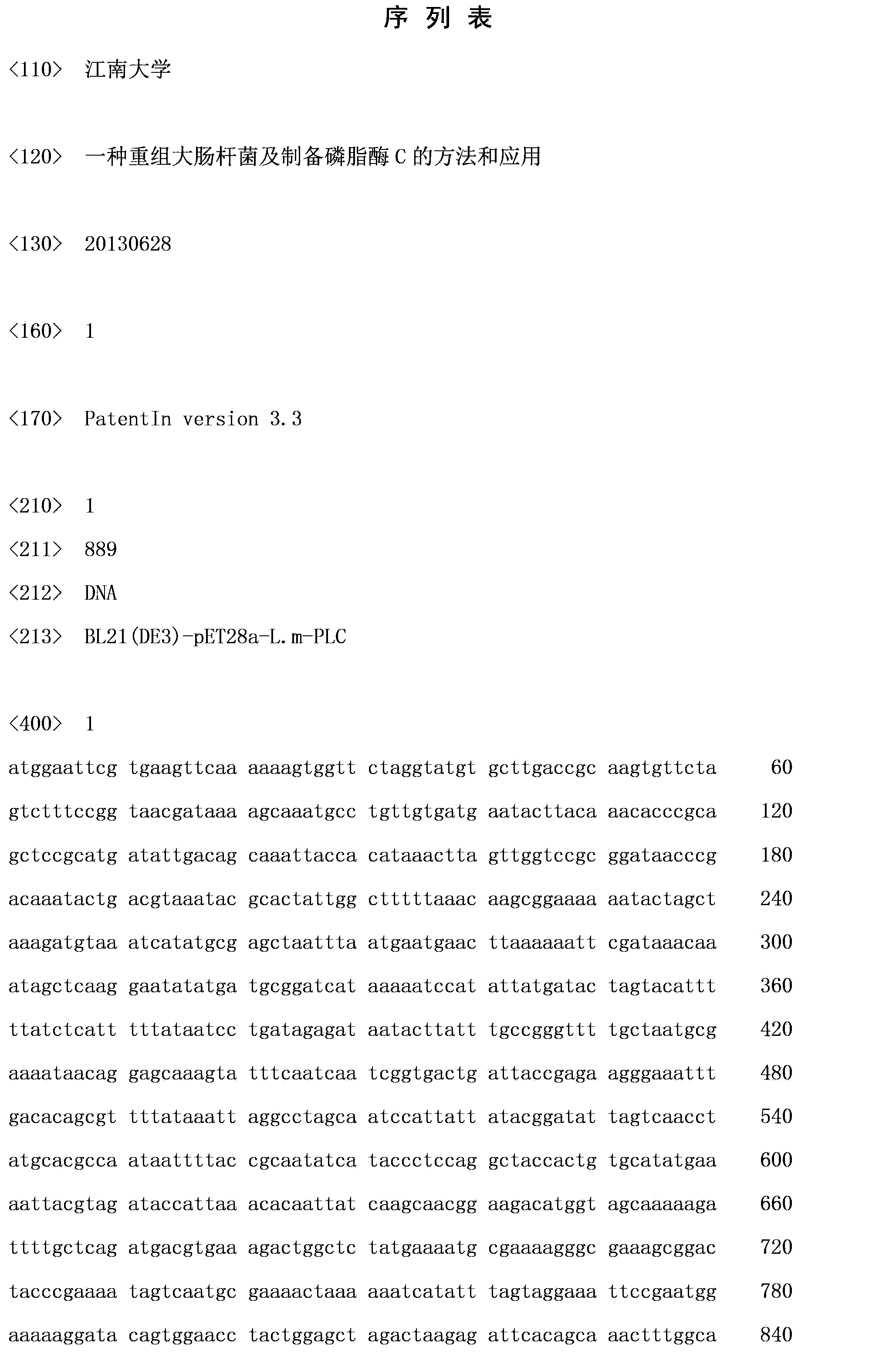Recombinant escherichia coli, method for preparing phospholipase C and application
A technology for recombining Escherichia coli and phospholipase, which is applied in the fields of enzyme genetic engineering and enzyme engineering, can solve problems such as non-application, and achieve the effects of low cost, high enzyme production and short production cycle.
- Summary
- Abstract
- Description
- Claims
- Application Information
AI Technical Summary
Problems solved by technology
Method used
Image
Examples
Embodiment 1
[0039] Cloning of embodiment 1 phospholipase C gene
[0040] Primers were designed according to the sequence of the plc gene of L.monocytogenes (YP005964174.1) provided by NCBI, where the upstream primers were:
[0041] 5'-CG GAATTC ATGTGTTGTGATGAATACTTACAAA-3' (the underlined part indicates the EcoR I restriction site);
[0042] Downstream primers are:
[0043] 5'-AT GCGGCCGC TTATTCATTTGTTTTTTT-3' (the underlined part indicates the NotI restriction site).
[0044] Using the genomic DNA of Listeria monocytogenes (L.monocytogenes) with the preservation number CICC No. 21540 as a template, the lysophospholipase C gene was cloned by PCR, and connected with the vector pMD18T-simple to construct a clone Vector pMD18T-simple-lm-plc, transform the cloning vector into Escherichia coli competent cells E.coli JM109, select positive clones, and sequence verification. The base sequence is shown in SEQ ID NO: 1, and the results show that the phospholipase C gene Cloning succeeded.
Embodiment 2
[0045] The construction of embodiment 2 recombinant plasmid pET-L.m-plc
[0046] The recombinant vector pMD18T-simple-lm-plc and the expression vector pET-28a (+) were double digested with EcoR I and Not I, and the enzyme digestion reaction system was 20 μL: plasmid 10 μL, Buffer 32 μL, Not I0.5 μL, EcoR I0. 5 μL, 100*Bsa 0.2 μL, H2O 6.8 μL. The target gene and carrier DNA were recovered and ligated with T4 DNA ligase. The ligation reaction system was 10 μL: 6 μL of target gene, 1.2 μL of carrier DNA, 1 μL of 10×T4 ligase buffer, 1 μL of T4 DNA ligase, and 0.8 μL of H200, and reacted at 16°C for 12 hours.
[0047] Transform the ligation product into Escherichia coli competent cells E.coli JM109, the transformation method is as follows:
[0048] (1) Add 10ul of the above ligation product to the E.coli JM109 competent cells (100ul / tube) that have been aliquoted, mix gently, and ice-bath for 30min;
[0049] (2) Put the above EP tube in a 42°C water bath, accurately time 90s, an...
Embodiment 3
[0055] Example 3 Construction of recombinant Escherichia coli BL21(DE3)-pET28a-L.m-PLC, deposit number CCTCC No.M2013301
[0056] Transform the constructed recombinant plasmid pET-L.m-plc into Escherichia coli BL21 (DE3), the transformation method is as follows:
[0057] (1) Add 0.5ul of the above-mentioned recombinant plasmid pET-lm-plc to 100μL of E.coli BL21 (DE3) competent cells (100ul / tube) that has been aliquoted, mix gently, and ice-bath for 30min;
[0058] (2) Put the above EP tube in a 42°C water bath, accurately time 90s, and do not shake the EP tube;
[0059] (3) Transfer the EP tube to an ice bath and cool for 3 minutes;
[0060] (4) Add 890 μL of sterile TB medium to each tube, place on a shaker at 37°C, 100r / min, and recover for 1h;
[0061] (5) Centrifuge at 8000r / min for 2min, suck off 800μL of supernatant medium, gently blow and suck the remaining medium and cells with a pipette gun, and transfer to LB solid containing kanamycin at a final concentration of 1...
PUM
 Login to View More
Login to View More Abstract
Description
Claims
Application Information
 Login to View More
Login to View More - R&D
- Intellectual Property
- Life Sciences
- Materials
- Tech Scout
- Unparalleled Data Quality
- Higher Quality Content
- 60% Fewer Hallucinations
Browse by: Latest US Patents, China's latest patents, Technical Efficacy Thesaurus, Application Domain, Technology Topic, Popular Technical Reports.
© 2025 PatSnap. All rights reserved.Legal|Privacy policy|Modern Slavery Act Transparency Statement|Sitemap|About US| Contact US: help@patsnap.com


